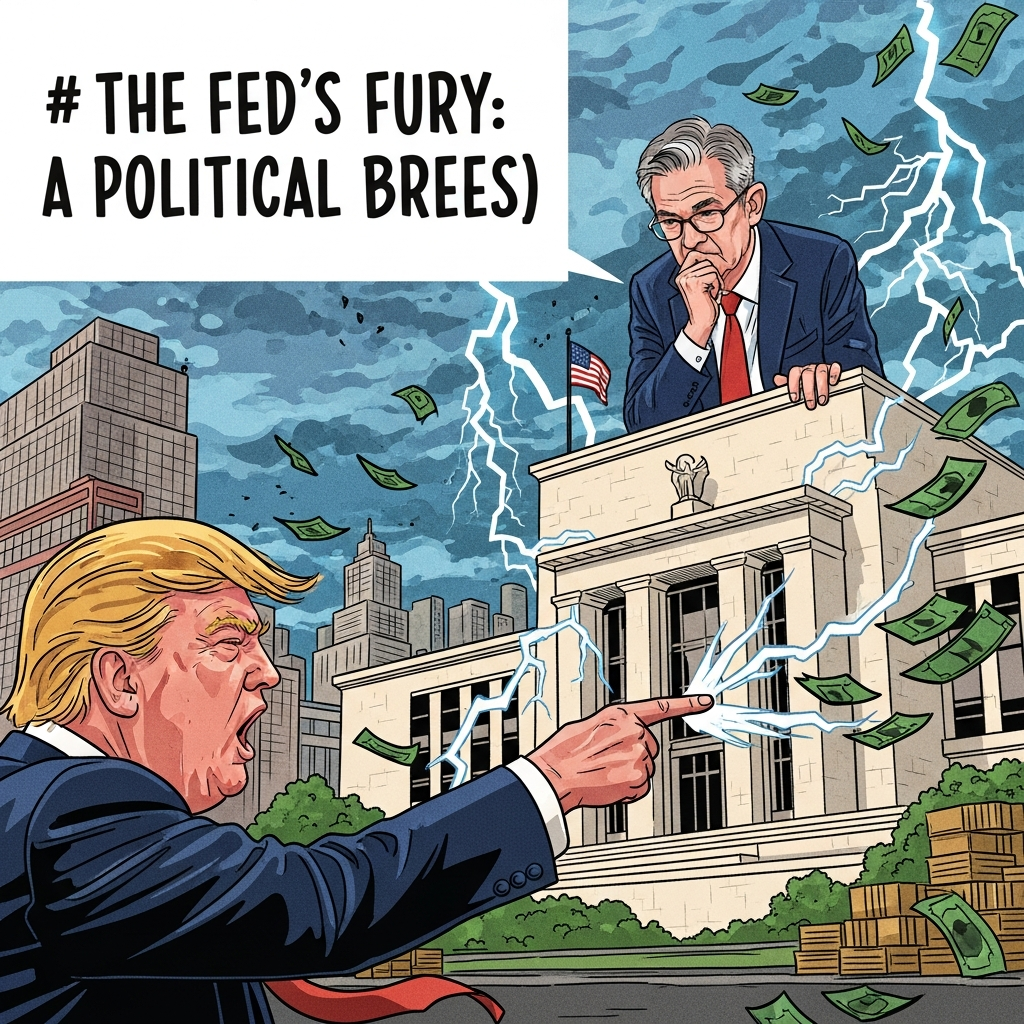The United States Federal Reserve, the nation’s central bank, operates with a carefully constructed shield of political independence. Yet, this crucial autonomy has repeatedly come under fire from former President Donald Trump. He has publicly expressed a fervent desire to remove current Federal Reserve Chair Jerome Powell, renewing aggressive calls for his termination and citing dissatisfaction with interest rate policies. This ongoing conflict isn’t just political theater; it represents a significant challenge to the stability of the U.S. economy and the foundational principles of monetary policy.
The Core Conflict: Trump’s Renewed Assault on Powell and the Fed
Donald Trump has consistently and unequivocally criticized Federal Reserve Chair Jerome Powell, whom he appointed in 2017. His primary grievance stems from the Fed’s stance on interest rates. Trump has openly stated he would “love to fire his ass” for not lowering rates as aggressively as he wished, even declaring that Powell’s “termination cannot come fast enough.” Speaking at various forums, Trump has frequently touted falling mortgage rates, but always with the caveat, “despite the Fed,” attempting to credit market forces while casting Powell as an obstacle to economic growth.
These threats are not new; they echo contentious statements from Trump’s previous term. His rhetoric suggests a belief that the Fed should align its monetary policy directly with presidential preferences, a notion that starkly contrasts with the institution’s mandate for independence. This relentless pressure places Powell and the Federal Reserve in a difficult position, caught between political demands and their duty to manage the economy impartially.
Federal Reserve Independence: A Legal and Historical Imperative
The concept of an independent central bank is a cornerstone of modern economic stability. The Federal Reserve’s structure, intentionally insulated from short-term political cycles, allows it to make decisions based solely on economic data and long-term objectives like price stability and maximum employment. This independence is not merely tradition; it is rooted in law.
Jerome Powell has consistently affirmed this legal framework, stating, “our independence is a matter of law” and that he is “not removable except for cause.” He publicly indicated in November that he would not resign if asked by a president. Historically, attempts by presidents to influence the Fed have often had detrimental consequences. For example, President Richard Nixon’s pressure to keep interest rates low before the 1972 election is widely believed by economists to have exacerbated the prolonged period of high inflation in the 1970s. Economic research overwhelmingly supports the notion that an independent central bank is more effective at controlling inflation and maintaining stable economic conditions, a view largely shared by Wall Street investors.
Can a President Fire a Fed Chair? Navigating the Legal Landscape
The question of whether a president can legally fire a Federal Reserve Chair like Jerome Powell is complex but generally understood to be highly restricted. The Federal Reserve Act specifies that governors, including the Chair, can only be removed “for cause.” Legal experts interpret “for cause” as referring to misconduct in office, not policy disagreements or prior private conduct.
This legal standard was recently highlighted by Trump’s attempt to fire Federal Reserve Governor Lisa Cook, citing allegations of mortgage fraud unrelated to her official duties. Cook vehemently rejected the claims and refused to resign, with her lawyer asserting that Trump’s demands “lacked any proper process, basis or legal authority” and that “no cause exists under the law.” Legal scholars widely viewed this as a “procedurally invalid removal,” reinforcing the idea that “for-cause” firings are not a tool for political expediency. While a Supreme Court case regarding presidential power over independent agencies exists, lawyers for the Trump administration have argued it doesn’t directly pertain to the Fed, and Powell has noted potential exemptions for the central bank.
Interest Rates, Inflation, and Trump’s Tariffs: A Complex Economic Web
Trump’s frustration with Powell centers on interest rates, but the Fed’s recent monetary policy decisions are far more nuanced than simple political preference. In 2022 and 2023, the Federal Reserve undertook sharp interest rate hikes to combat surging inflation, successfully bringing it down from a peak of 9.1% in 2022 to a figure close to its 2% target. They even cut rates three times at the end of the previous year.
The current decision by Powell and most Fed policymakers to keep rates on hold is largely attributed to the “uncertainty created by Trump’s sweeping tariffs,” including a proposed 10% tax on all imports and a 145% levy on imports from China. Powell explicitly warned that these tariffs would “likely worsen inflation,” necessitating elevated rates to maintain price stability. This puts the Fed in a difficult position: Trump’s trade policies could trigger inflation, forcing the Fed to keep rates high, which would then draw further criticism from Trump. Countering Trump’s claim that rates are rising due to Powell “playing politics,” observations show that longer-term interest rates actually increased after Trump announced his trade penalties.
Trump’s Evolving Stance and Allegations of Mismanagement
Interestingly, Trump’s public stance on Powell has not always been consistently aggressive. In a 2024 campaign interview, he indicated he would allow Powell to serve out his term, and his top economic adviser previously asserted there would be “no political coercion over the Fed.” However, the renewed attacks suggest a shift back to direct confrontation.
Beyond policy, the Trump administration has also sought to build a case of “mismanagement” against Powell, notably scrutinizing the Federal Reserve headquarters’ renovation project for reportedly overrunning its budget. Powell responded by affirming commitment to transparency and asking the Fed’s Inspector General to conduct a “fresh look.” This tactic highlights another avenue for presidential pressure, attempting to undermine the Fed Chair’s authority and credibility through allegations of administrative missteps. Ultimately, many analysts suggest that Trump’s persistent criticism of Powell may be an attempt to “pin the blame on Powell” for economic weakening caused by his own trade policies. His tariff plans, for instance, have amplified the “threat of a recession with higher inflationary pressures and slower growth,” leading to a “financial market backlash,” increased recession odds from Goldman Sachs, and a Yale University Budget Lab estimate that tariffs could cost an average U.S. household $4,900.
What This Means for the Economy and You
The ongoing conflict between the White House and the Federal Reserve carries significant implications for the U.S. economy and the financial well-being of everyday Americans. Political interference in monetary policy creates market uncertainty, which can deter investment and lead to volatility. If the Fed’s independence is compromised, there is a heightened risk of policies designed to serve short-term political gains rather than long-term economic stability. This could result in higher, more volatile inflation, eroding purchasing power and increasing the cost of living.
For individuals, such instability can translate into higher borrowing costs for mortgages, car loans, and credit cards, making it more expensive to finance major purchases. It can also impact job growth and investment, ultimately affecting overall economic prosperity. Understanding these dynamics is crucial for citizens to appreciate the delicate balance required to maintain a healthy and stable economy.
Frequently Asked Questions
What is the Federal Reserve’s primary role, and why is its independence so important?
The Federal Reserve’s primary role is to maintain price stability, maximize employment, and ensure the stability of the U.S. financial system. Its independence is crucial because it allows the central bank to make monetary policy decisions based on economic data and analysis, free from short-term political pressures or electoral cycles. This insulation helps prevent policies that might provide immediate political benefits but lead to long-term economic harm, such as unchecked inflation or severe recessions, as seen during the 1970s when political influence on the Fed was higher.
What are the legal limitations on a U.S. President trying to remove a Federal Reserve Chair like Jerome Powell?
A U.S. President’s power to remove a Federal Reserve Chair is highly limited. The Federal Reserve Act stipulates that a governor, including the Chair, can only be removed “for cause.” Legal interpretations of “for cause” typically refer to serious misconduct or neglect of duty in office, not policy disagreements with the president or issues predating their appointment. This legal standard is designed to safeguard the Fed’s autonomy and prevent a president from summarily dismissing a Fed Chair simply for disagreeing with their economic policies, as highlighted by Governor Lisa Cook’s recent stand against attempted removal.
How could presidential intervention in Federal Reserve policy, such as firing its Chair, impact the average American household?
Presidential intervention in Federal Reserve policy, particularly through efforts to remove its Chair, could have severe economic consequences for average American households. It would create immense market uncertainty, potentially leading to higher inflation as investor confidence wanes and monetary policy becomes unpredictable. This could translate into significantly higher interest rates for mortgages, car loans, and credit cards, increasing borrowing costs for families. Furthermore, political influence on the Fed could lead to policies that destabilize the economy, threatening job security, investment, and the overall purchasing power of household incomes, with some estimates suggesting significant financial losses due to related policies like tariffs.
Conclusion: Safeguarding Economic Stability Amidst Political Pressure
The ongoing confrontation between former President Donald Trump and Federal Reserve Chair Jerome Powell underscores a fundamental tension in American governance: the balance between presidential power and institutional independence. While a president may express strong opinions on economic policy, the legal framework protecting the Federal Reserve’s autonomy is designed to serve a greater purpose – the long-term stability and health of the U.S. economy. The historical lessons, legal precedents, and economic research all point to the critical importance of an independent central bank in navigating complex global economic challenges. As this “battle for control” continues, understanding its implications is paramount for every American, as the stakes involve nothing less than the nation’s economic future.




